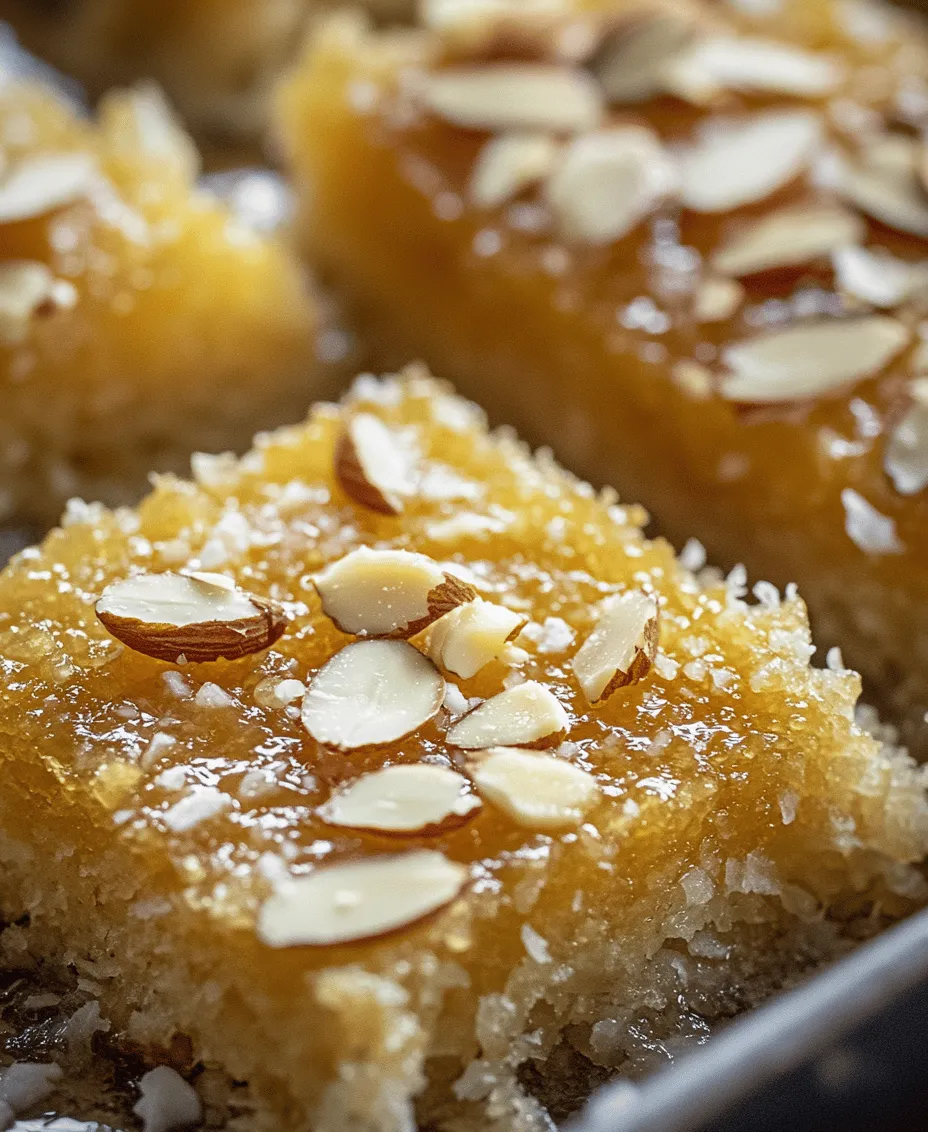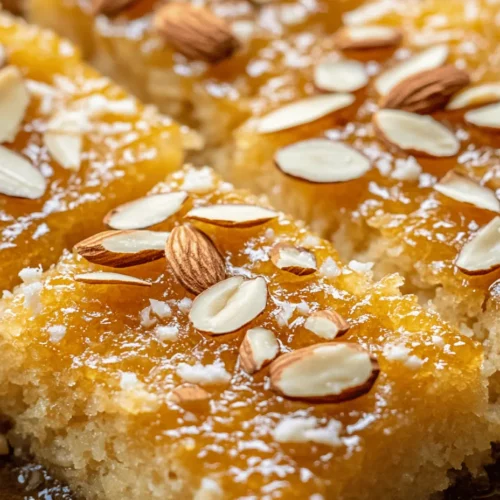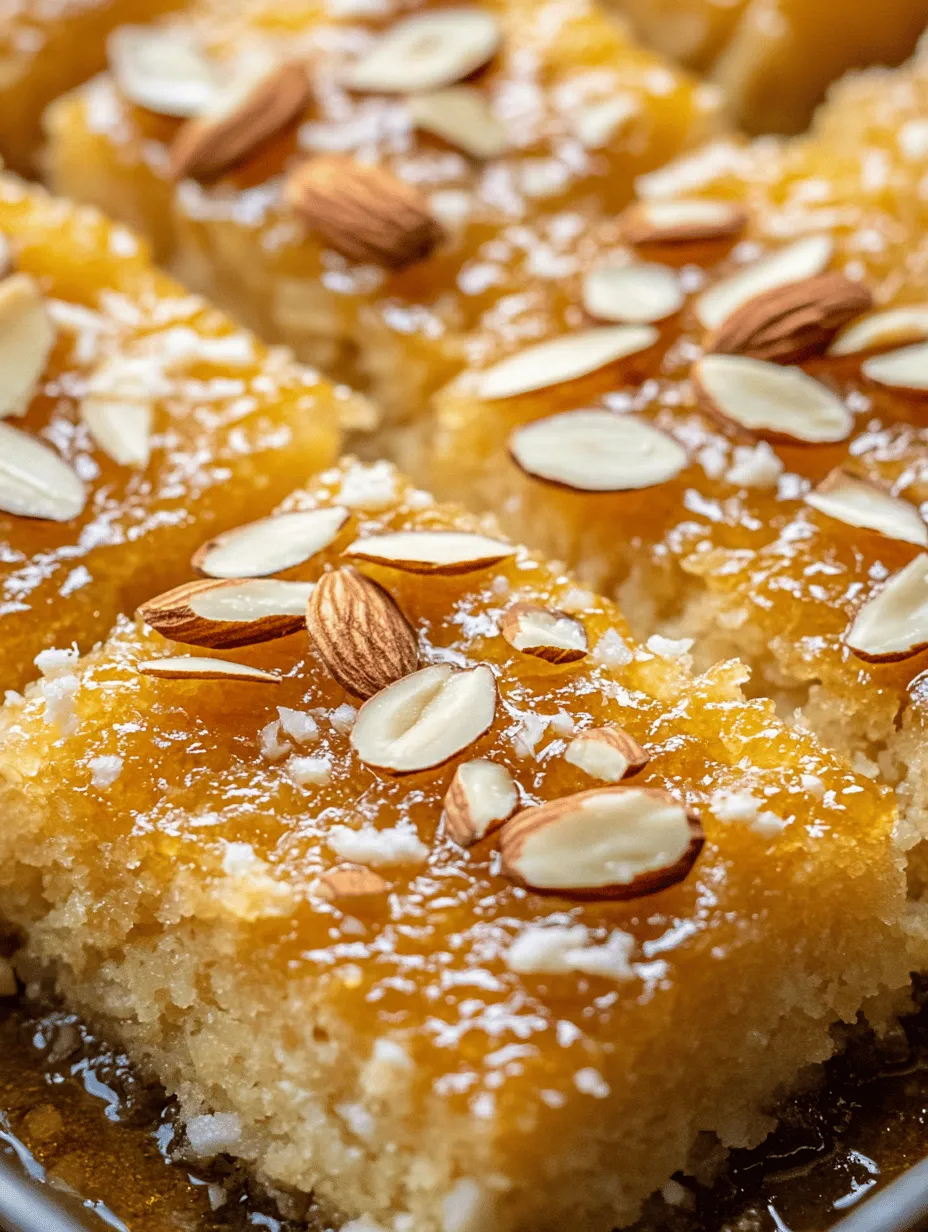Introduction
Basbousa, a beloved traditional dessert from the Middle East, captures the hearts and taste buds of many with its unique texture and delightful sweetness. Known for its moist, cake-like consistency, Basbousa is often enjoyed as a special treat during festive occasions, family gatherings, or simply as a comforting dessert at home. This dish has transcended its origins, finding a place in various cultures across the region, each adding its own twist to the classic recipe. Whether served plain or adorned with nuts and syrup, Basbousa is a testament to the rich culinary heritage of the Middle East.
What sets this particular recipe apart is the stovetop method of preparation. Traditionally baked in an oven, the stovetop version makes this delicious dessert accessible to all home cooks, regardless of their kitchen equipment. With minimal ingredients and a straightforward process, you can create a heavenly Basbousa that rivals any bakery’s offering. In this article, we’ll explore the origins of Basbousa, the essential ingredients that make it special, and guide you through the initial steps of making this delightful dessert.
Understanding Basbousa
Basbousa, also known as Hareeseh or Revani in various regions, is more than just a dessert; it embodies a part of Middle Eastern culture and tradition. The name “Basbousa” is derived from the Arabic word “basbasa,” which means “to moisten,” perfectly describing the cake’s texture. Its base is primarily made from semolina, which gives it a distinct grainy texture that sets it apart from other cakes.
Historically, Basbousa has roots tracing back to the Ottoman Empire, where it was enjoyed by royalty and commoners alike. Over time, regional variations have emerged, each infused with local flavors and ingredients. For instance, in Egypt, it may be topped with almonds, while in Turkey, it is often flavored with citrus and served with a drizzle of syrup.
The cultural significance of Basbousa extends beyond just its taste; it is often served during Ramadan and Eid celebrations, symbolizing hospitality and the joy of sharing food with loved ones. Regardless of the occasion, Basbousa brings people together, making it a cherished dessert in many homes.
Common Ingredients and Their Roles in the Recipe
To create the perfect Basbousa, understanding the role of each ingredient is crucial. Here’s a breakdown of the main components:
– Semolina: This is the star ingredient of Basbousa, giving it a unique texture that is both soft and slightly grainy. Semolina flour absorbs moisture well, resulting in a cake that is moist yet firm enough to hold its shape.
– Yogurt: Yogurt is a key ingredient that adds moisture and richness to the cake. Its acidity also helps to tenderize the batter, creating a soft and fluffy texture. Additionally, it contributes a subtle tanginess that balances the sweetness.
– Sugar: Sugar not only sweetens the cake but also plays a role in the syrup that is poured over it after cooking. It enhances the overall flavor profile and helps to maintain moisture in the finished dessert.
– Unsalted Butter: Butter adds richness and flavor to Basbousa. It contributes to the cake’s tender crumb and provides a luxurious mouthfeel. Using unsalted butter allows you to control the saltiness of the dish.
– Baking Powder: This essential leavening agent ensures the Basbousa rises properly, giving it a light and airy texture. It helps to create a cake that is fluffy and not dense.
– Vanilla Extract: A splash of vanilla extract elevates the flavor of the cake, adding depth and warmth. It complements the sweetness and enhances the overall aromatic experience of the dessert.
– Desiccated Coconut (optional): While not a traditional ingredient, desiccated coconut adds a delightful chewiness and tropical flavor to Basbousa. It can be included for those who enjoy a hint of coconut in their desserts.
– Almonds: Traditionally used as a garnish, almonds add a nice crunch and visual appeal to the finished cake. They can be placed on top before cooking or used as a decorative touch after the Basbousa is complete.
– Syrup Components: The syrup is a critical element of Basbousa, transforming it from a simple cake into a luscious dessert. The standard components include:
– Water: Forms the base of the syrup, helping to dissolve the sugar.
– Sugar: Sweetens the syrup and helps to create a glossy finish on the cake.
– Lemon Juice: Adds acidity, balancing the sweetness of the syrup and preventing it from crystallizing.
– Rose Water: Often used in Middle Eastern desserts, rose water imparts a delicate floral aroma, enhancing the sensory experience of the Basbousa.
Ingredients Breakdown
Now that we understand the roles of each ingredient, let’s gather everything you’ll need to create your own heavenly stovetop Basbousa. Below is a comprehensive list of the ingredients required for this recipe:
Main Ingredients
– 1 cup semolina flour
– 1 cup plain yogurt
– 1 cup granulated sugar
– ½ cup unsalted butter, melted
– 1 teaspoon baking powder
– 1 teaspoon vanilla extract
– ½ cup desiccated coconut (optional)
– Almonds for garnish (optional)
Syrup Ingredients
– 1 cup water
– 1 cup granulated sugar
– 2 tablespoons lemon juice
– 1 tablespoon rose water (optional)
With all your ingredients ready, you’re set to embark on the delightful journey of making stovetop Basbousa. The next step will guide you through the preparation and cooking process, ensuring that you achieve a perfectly moist and flavorful dessert that will impress family and friends alike.
Stay tuned for the detailed instructions and tips to perfect your Basbousa, making your kitchen the sweetest spot in your home.

Preparation Steps
Syrup Preparation
To achieve the quintessential balance of sweetness and tanginess in Basbousa, the syrup is a crucial element. Begin by combining one cup of granulated sugar with one cup of water in a saucepan. Heat the mixture over medium heat, stirring occasionally until the sugar fully dissolves. This step is vital, as undissolved sugar can create a gritty texture in the syrup.
Once the sugar is dissolved, add the juice of half a lemon. This not only enhances the flavor but also helps in preventing the syrup from crystallizing. Continue to simmer the mixture for about 10 minutes until it slightly thickens. The syrup should have a consistency similar to that of honey; it should coat the back of a spoon without being overly viscous. Allow the syrup to cool before drizzling it over the warm Basbousa, ensuring that the cake absorbs the syrup effectively, resulting in a moist and flavorful dessert.
Mixing the Batter
Creating the perfect Basbousa batter is a straightforward yet significant process. In a large mixing bowl, combine one cup of semolina, one cup of plain yogurt, and half a cup of sugar. Using a whisk, blend these ingredients thoroughly to ensure a smooth and homogeneous mixture.
Next, incorporate half a cup of unsweetened coconut flakes for added texture and flavor. If desired, you can also mix in half a teaspoon of baking powder, which will give your Basbousa a lighter texture. Stir the batter until all ingredients are well-combined, ensuring there are no lumps. For an additional touch, consider adding a splash of vanilla extract to enhance the flavor profile.
Cooking on Stovetop
Transfer the batter into a greased non-stick skillet or a heavy-bottomed pan. Spread the mixture evenly using a spatula to achieve a uniform thickness. Place the skillet over low to medium heat. It’s important to monitor the temperature closely as high heat can lead to uneven cooking or burning on the bottom.
Cover the skillet with a lid to create a steaming effect, which helps cook the Basbousa evenly throughout. Allow it to cook for approximately 30 to 40 minutes. Check for doneness by gently shaking the pan; the center should be firm and not jiggle.
Importance of Checking Doneness
To ensure your Basbousa is perfectly cooked, perform a simple doneness test. Insert a toothpick or a knife into the center of the cake. If it comes out clean or with a few moist crumbs, your Basbousa is ready. If the toothpick comes out with wet batter, continue cooking for another 5 to 10 minutes, keeping a close eye to avoid overcooking.
Serving Suggestions
Presentation Ideas
Once your Basbousa is cooked and has absorbed the syrup, it’s time to present this delightful dessert. Allow it to cool slightly before cutting it into diamond or square shapes. Using a sharp knife, make clean cuts to ensure each piece retains its shape.
For an elegant presentation, consider garnishing each piece with a blanched almond or a sprinkle of shredded coconut. Arrange the pieces on a decorative platter, and for an added touch, dust with powdered sugar before serving. This simple but beautiful presentation elevates the appeal of your homemade Basbousa.
Pairing Options
Basbousa is a versatile dessert that pairs well with a variety of beverages. Traditional pairings include a strong cup of Arabic coffee or a refreshing mint tea. The bold flavors of these drinks complement the sweetness of the Basbousa beautifully.
Alternatively, you can serve it with a dollop of whipped cream or a scoop of vanilla ice cream for a modern twist. Fresh fruits, such as berries or citrus slices, also serve as a refreshing accompaniment, balancing the richness of the cake.
Storage Tips
To maintain the freshness of your Basbousa, store any leftovers in an airtight container at room temperature. It will keep well for three to four days. If you prefer, you can refrigerate it, but be aware that this may alter the cake’s texture, making it slightly denser. When ready to serve, allow the Basbousa to come to room temperature for the best flavor experience.
Cultural Variations and Adaptations
Overview of Cultural Adaptations
Basbousa, known by various names such as Hareeseh or Revani in different cultures, showcases how culinary traditions can evolve while retaining their essence. In Egypt, Basbousa is often flavored with orange blossom water, while in Turkey, it may include nuts or spices, creating unique regional variations.
Alternative Ingredients for Dietary Restrictions
For those with dietary restrictions, Basbousa can easily be adapted. To make a gluten-free version, substitute semolina with finely ground almond flour or gluten-free flour blends. For vegan adaptations, replace yogurt with a plant-based yogurt or applesauce, and use a flaxseed or chia seed mixture as an egg substitute if needed.
Variations in Syrup Flavoring
While the classic syrup for Basbousa is lemon-flavored, you can experiment with different extracts or spices to enhance the taste. Consider infusing the syrup with cardamom, rosewater, or even a splash of orange juice for a fragrant twist. These variations allow you to customize the dessert to your taste preferences.
The Joy of Stovetop Cooking
Benefits of the Stovetop Method
Cooking Basbousa on the stovetop has several advantages. It requires less energy than heating an entire oven, making it more efficient, especially during hot weather. The stovetop method also allows for greater control over temperature, reducing the risk of burning or uneven cooking.
Comparisons with Traditional Oven Baking
While baking Basbousa in the oven is a popular method, the stovetop offers a unique texture that some may prefer. Oven-baked Basbousa tends to have a drier crust, whereas stovetop cooking can yield a moister, more tender cake. Each method has its pros and cons, but experimenting with both can yield delightful results.
Encouragement to Experiment
Don’t hesitate to make this Basbousa recipe your own! Add your favorite flavors, experiment with toppings, and adjust the sweetness to your liking. The beauty of cooking is that it allows for creativity. By making this recipe your own, you not only embrace the tradition of Basbousa but also infuse it with your personal touch.
Conclusion
In summary, this Heavenly Stovetop Basbousa is not only a delicious dessert but also a testament to the beauty of homemade cooking. With its rich flavor, moist texture, and versatility, Basbousa holds a special place in gatherings and celebrations across cultures.
The ease of preparing this beloved traditional dish at home, combined with the satisfaction of sharing it with loved ones, makes it a rewarding culinary experience. Whether you serve it at a festive occasion or enjoy it as an afternoon treat, Basbousa is sure to delight the taste buds and bring joy to any table. Embrace the simplicity and flavor of this incredible dessert, and let it become a cherished addition to your recipe repertoire.



